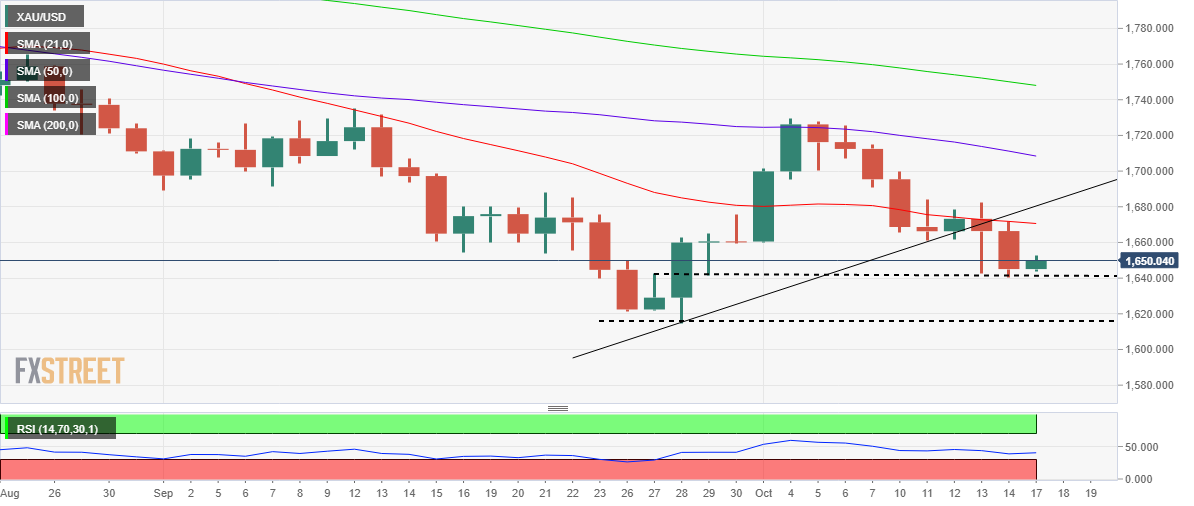- Gold price sees fresh demand, as the US dollar drops at the start of a new week.
- USD decline looks temporary amid hawkish Fed outlook, UK political uncertainty.
- XAU/USD sees a dead cat bounce after last week’s, and ahead of a data-light week.
Gold price is making a minor recovery attempt from near the $1,640 region, as the US dollar gives up a part of Friday’s turnaround at the start of the week. The dollar retreat could be associated with the lackluster performance in the US Treasury yields across the curve while the upswing in the GBP/USD also added to weakness in the buck. Bank of England (BOE) Governor Andrew Bailey’s recent comments and chatter over the UK political upheaval have propelled cable 0.50% higher on the day to 1.1250.
However, the rebound in the bright metal could be temporary, as the greenback could pick up safe-haven bids should markets turn more risk-averse. Investors remain on edge, despite the gains in the S&P 500 futures, as looming global recession risks, China doubling down on its zero-Covid policy and aggressive US interest rate hike outlook continue to sap their confidence.
Also read: Gold Price: Halloween comes early, XAU/USD back below critical bearish structure $,1670
On the economic data front, there is not much relevance on the US docket this Monday, therefore, Fedspeak will continue to impact the dynamics of the dollar and the yields, eventually influencing the yieldless gold. The developments surrounding UK politics will also significantly affect risk sentiment while attention shifts towards China’s Q3 GDP release later this week.
“The Chinese economy is forecast to expand at an annualized rate of 3.4% in the third quarter following the dismal 0.2% growth recorded in the second quarter. In case the GDP data falls below the market expectation, gold could have a hard time finding demand and vice versa,” FXStreet’s Senior Analyst, Eren Sengezer explains.
Gold price technical outlook: Daily chart
Following last week’s break below the rising trendline support, then at $1,670, sellers have remained in complete control. That level now coincides with the mildly bearish 21-Daily Moving Average (DMA).
Unless bulls find a strong foothold above the latter, any recovery attempts in the bright metal from two-week lows of $1,640 appear to be a dead cat bounce.
The immediate upside barrier is seen at the $1,650 level above which the previous intermittent lows around $1,660 could enact strong resistance.
The 14-day Relative Strength Index (RSI) is trading flatlined below the 50.00 level, keeping the bearish potential intact.
Therefore, daily candlestick closing below the $1,640 demand area is needed for a fresh downswing towards the $1,600 mark.
Ahead of that, the September low of $1,615 will challenge the bearish commitments.
Information on these pages contains forward-looking statements that involve risks and uncertainties. Markets and instruments profiled on this page are for informational purposes only and should not in any way come across as a recommendation to buy or sell in these assets. You should do your own thorough research before making any investment decisions. FXStreet does not in any way guarantee that this information is free from mistakes, errors, or material misstatements. It also does not guarantee that this information is of a timely nature. Investing in Open Markets involves a great deal of risk, including the loss of all or a portion of your investment, as well as emotional distress. All risks, losses and costs associated with investing, including total loss of principal, are your responsibility. The views and opinions expressed in this article are those of the authors and do not necessarily reflect the official policy or position of FXStreet nor its advertisers. The author will not be held responsible for information that is found at the end of links posted on this page.
If not otherwise explicitly mentioned in the body of the article, at the time of writing, the author has no position in any stock mentioned in this article and no business relationship with any company mentioned. The author has not received compensation for writing this article, other than from FXStreet.
FXStreet and the author do not provide personalized recommendations. The author makes no representations as to the accuracy, completeness, or suitability of this information. FXStreet and the author will not be liable for any errors, omissions or any losses, injuries or damages arising from this information and its display or use. Errors and omissions excepted.
The author and FXStreet are not registered investment advisors and nothing in this article is intended to be investment advice.
Recommended Content
Editors’ Picks

AUD/USD consolidates near two-month top; remains below 0.6400 ahead of Aussie jobs data
AUD/USD oscillates below the 0.6400 mark as bulls pause for a breather after the recent sharp rally to a nearly two-month high touched the previous day and ahead of Australian jobs data. The RBA's cautious signal on further interest rate cuts, hopes for more stimulus from China, and Trump's temporary tariff reprieve acts as a tailwind for the Aussie.

USD/JPY stages a recovery from multi-month low; upside seems limited
USD/JPY rebounds from the 141.60 area, or a seven-month trough touched during the Asian session on Thursday amid a modest USD bounce, though it lacks follow-through as trade-war woes continue to underpin the safe-haven JPY.

Gold price extends the record run amid US tariffs-inspired rush to safety
Gold price builds on the previous day's breakout momentum above the $3,300 mark and touches a fresh all-time peak during the Asian session on Thursday. Tariff uncertainty, the escalating US-China trade war, global recession fears, and expectations of more aggressive Fed easing continue to support XAU/USD.

Ethereum face value-accrual risks due to data availability roadmap
Ethereum declined 1%, trading just below $1,600 in the early Asian session on Thursday, as Binance Research's latest report suggests that the data availability roadmap has been hampering its value accrual.

Future-proofing portfolios: A playbook for tariff and recession risks
It does seem like we will be talking tariffs for a while. And if tariffs stay — in some shape or form — even after negotiations, we’ll likely be talking about recession too. Higher input costs, persistent inflation, and tighter monetary policy are already weighing on global growth.

The Best brokers to trade EUR/USD
SPONSORED Discover the top brokers for trading EUR/USD in 2025. Our list features brokers with competitive spreads, fast execution, and powerful platforms. Whether you're a beginner or an expert, find the right partner to navigate the dynamic Forex market.
